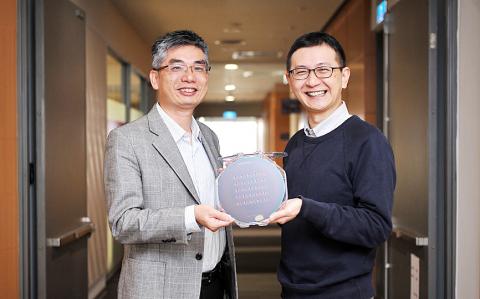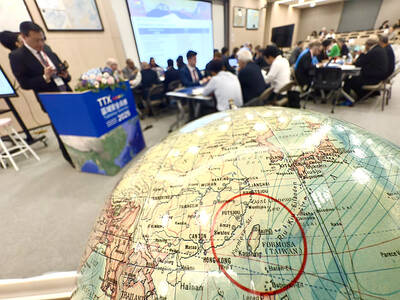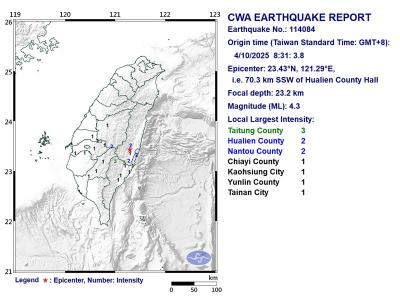A team led by National Tsing Hua University (NTHU) professors yesterday announced a breakthrough in magnetic random access memory (MRAM) semiconductor research.
MRAM is considered a better memory device than dynamic random access memory (DRAM) and static random access memory (SRAM), as it is faster and more energy-efficient, and its stored information remains intact even when it is powered down, NTHU Department of Materials Science and Engineering professor Lai Chih-huang (賴志煌) said.
MRAM works by manipulating its ferromagnetic and antiferromagnetic layers (classes of magnetic materials), but researchers have been working to make the manipulation more flexible, without having to change the MRAM’s external temperature, Lai said.

Photo: Chien Hui-ju, Taipei Times
After adding a platinum layer under the ferromagnetic and antiferromagnetic layers, the team succeeded in using a spin current caused by the flow of electrons to manipulate their “exchange bias,” a phenomenon occurring in magnetic multilayers where the antiferromagnetic layer “fixes” the ferromagnetic layer, he said.
The team is the world’s first to use a spin current to manipulate the exchange bias, resolving an obstacle that researchers have battled with for the past 60 years, he said.
Understanding spin current is vital for semiconductor development, as it has been pushed to the extreme, he said.
The team patented the technique in Taiwan, the US and China before publishing their findings in a paper titled “Manipulating exchange bias by spin-orbit torque” in the journal Nature Materials on Feb. 18, Lai said.
To verify their experiments, the team also developed techniques to measure temperature variations in microseconds, NTHU Department of Physics professor Lin Hsiu-hau (林秀豪) said.
While most scientists are still debating whether a spin current can manipulate the switching of micromagnets beyond 1 nanometer, the team has demonstrated that manipulations caused by a spin current can persist for more than several nanometers, Lin said.
After submitting their manuscript to the journal, the team spent more than one year convincing the journal’s reviewers that it was a Taiwanese team who achieved the breakthrough, despite limited funding, he added.
Funded by the Ministry of Science and Technology, the team also works with the ministry’s Taiwan Semiconductor Research Institute and other universities, Lai said.
Their technique might be used in the mass production of new MRAM devices in four or five years, Lai said, adding that they are meeting with domestic semiconductor firms to discuss a technology transfer.

Taiwan is stepping up plans to create self-sufficient supply chains for combat drones and increase foreign orders from the US to counter China’s numerical superiority, a defense official said on Saturday. Commenting on condition of anonymity, the official said the nation’s armed forces are in agreement with US Admiral Samuel Paparo’s assessment that Taiwan’s military must be prepared to turn the nation’s waters into a “hellscape” for the Chinese People’s Liberation Army (PLA). Paparo, the commander of the US Indo-Pacific Command, reiterated the concept during a Congressional hearing in Washington on Wednesday. He first coined the term in a security conference last

DEFENSE: The National Security Bureau promised to expand communication and intelligence cooperation with global partners and enhance its strategic analytical skills China has not only increased military exercises and “gray zone” tactics against Taiwan this year, but also continues to recruit military personnel for espionage, the National Security Bureau (NSB) said yesterday in a report to the Legislative Yuan. The bureau submitted the report ahead of NSB Director-General Tsai Ming-yen’s (蔡明彥) appearance before the Foreign and National Defense Committee today. Last year, the Chinese People’s Liberation Army (PLA) conducted “Joint Sword-2024A and B” military exercises targeting Taiwan and carried out 40 combat readiness patrols, the bureau said. In addition, Chinese military aircraft entered Taiwan’s airspace 3,070 times last year, up about

A magnitude 4.3 earthquake struck eastern Taiwan's Hualien County at 8:31am today, according to the Central Weather Administration (CWA). The epicenter of the temblor was located in Hualien County, about 70.3 kilometers south southwest of Hualien County Hall, at a depth of 23.2km, according to the administration. There were no immediate reports of damage resulting from the quake. The earthquake's intensity, which gauges the actual effect of a temblor, was highest in Taitung County, where it measured 3 on Taiwan's 7-tier intensity scale. The quake also measured an intensity of 2 in Hualien and Nantou counties, the CWA said.

The Overseas Community Affairs Council (OCAC) yesterday announced a fundraising campaign to support survivors of the magnitude 7.7 earthquake that struck Myanmar on March 28, with two prayer events scheduled in Taipei and Taichung later this week. “While initial rescue operations have concluded [in Myanmar], many survivors are now facing increasingly difficult living conditions,” OCAC Minister Hsu Chia-ching (徐佳青) told a news conference in Taipei. The fundraising campaign, which runs through May 31, is focused on supporting the reconstruction of damaged overseas compatriot schools, assisting students from Myanmar in Taiwan, and providing essential items, such as drinking water, food and medical supplies,